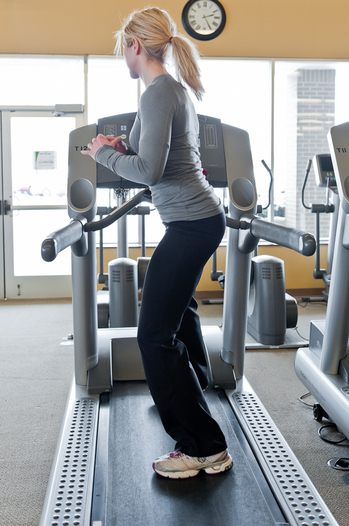Functional training: A key for fitness enthusiasts and athletes alike

Directional treadmill training... looks weird but has value!
Photo by Bud Gibson
In part 1 of this series, I talked about the importance of neutral posture and how it can dramatically improve both your overall health and your fitness results. In this post I will define the term functional training (a method of training) and explain how it applies to both fitness results and sports performance.
Personally, I incorporate functional movement into almost all my workouts, and it allows me to continue to improve my athletic performance even at a recreational level. I also use these same theories with all of my clients, no matter their age or athletic ability, and it allows them to progress forward no matter what their starting point. If you are a do-it-yourselfer when it comes to working out, I recommend reviewing my site or sites such as Perform Better for information and tips on functional training and fitness results.
What is functional training?
Functional training is a method of training that is based on preparing the body for real-world challenges such as balance, stability, turning, bending and lifting. Having the ability to perform these types of tasks using the proper form and biomechanics is the key to maintaining health, continually challenging oneself during workouts, and remaining injury free.
As many of us have experienced, when performed incorrectly, anything from getting out of bed or standing up from a chair to moving furniture or climbing stairs can cause knee damage, back aches, tightness in the neck or, even worse, herniated disks and days without being able to move freely or work out. Using a functional training regimen at the gym, you include practicing balance by using a BOSU ball or performing a single leg exercise with control, stability and form. Mastering these movements within the gym then translates into real world situations. The gym is perfect place to practice everyday movements because it’s a controlled environment. For example, by practicing balance in the gym, a person would be more prepared to catch himself and prevent injury if he fell or slipped on ice.
Functional training & fitness results
The first steps to functional training involve controlling your own body weight, improving balance and developing core stability. As you learn how to perform movements correctly, you activate the appropriate muscle groups, develop balanced musculature and challenge yourself more effectively during workouts. This in turn translates into better mobility, safer workouts and better overall fitness results.
Without using proper form or learning body control, you often take advantage of leverage and momentum during strength movements. By using momentum and leverage, exercisers can unknowingly compromise joint health, develop imbalances and complete less total work during a workout (fewer calories burned).
Do you ever wonder why you see some people walking backwards and sideways on the treadmill? I often see people doing this type of training and wonder if they realize the benefit they are giving themselves. Directional training is a component of functional training that allows the exerciser to train the body in different directions, improving balance, body awareness and mobility and strengthening muscles, ligaments and tendons by placing a different type of ‘load’ on them. If you ever attempt this, you should attempt to maintain appropriate posture and start at very slow speeds.
Functional training & sports performance
A well planned sports-oriented training protocol includes movement that mimics what the athlete will be doing on the field, court or ice. Training often includes components of speed, agility, strength, power and endurance. While each of these elements is important to training a well rounded athlete, functional training also deserves a place on the list.
A good functional training plan teaches the athlete to perform all movements with proper biomechanics and body control. Functional training also trains the nervous system to utilize core strength with every movement. The combination of training with proper biomechanics and body control while utilizing core strength translates into improved ability to generate speed, power and therefore increases an athletes overall ability to perform.
Conclusion
In this post I have discussed functional training and its benefits for both exercisers and athletes. In my next post, I will demonstrate some simple techniques for improving body awareness, lateral and backwards movement. If you have questions or comments, leave them here and I will try to answer quickly. Thanks for reading!

